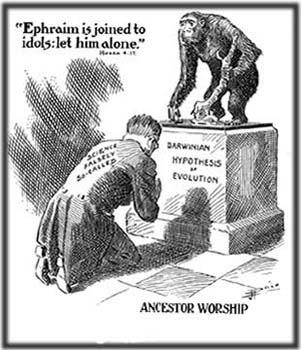In honor of Darwin Day earlier this month, Slate ran a thorough article about the creationist movement in America and one of its leading evangelists, Ken Ham of Answers in Genesis. As the article points out, the science is at best a secondary concern for them: their certainty is founded on a literal reading of the Bible (which explicitly trumps any evidence, according to their statements of faith). Their primary concern is that they believe acceptance of evolution leads to sin, like abortion and tolerance of gay people, and that by defeating evolution with pseudoscientific arguments, they can save people from God’s eternal wrath.
To promote this apologetic message, Ham has built a media empire whose centerpiece is the Creation Museum in Petersburg, Kentucky. But lately, the Creation Museum has fallen on hard times:
In 2012, the Creation Museum reported a 10 percent decline in attendance from the previous year, and its parent group, Answers in Genesis, posted a 5 percent drop in revenue. That continues a four-year slump and a new low for the museum at 280,000 total visitors last year.
And it gets worse for the creationists. To follow up on his museum, Ham wanted to build a theme park called “Ark Encounter”, which would have featured a full-size replica of Noah’s ark. (If built, I suspect this would have just driven home the point about how impossible it would have been to fit two of every species inside – particularly when you include the dinosaurs, which he’s adamant were on board.)
As I wrote about in 2011, the government of Kentucky bent over backwards to offer tax breaks and other incentives to Ham’s leaky boat. But even with that help, fundraising has stalled and the project’s future is in doubt:
Even more ominously, fundraising for the Ark Encounter has slowed to a crawl. Its future is further imperiled by the decline of the Creation Museum, whose visitors were expected to be a huge source of funding for the ark park. As of January, Ham had failed to raise even half the money required to build the ark replica itself, let alone the rest of the park.
The economic slump is probably part of the cause, especially since Ham’s target audience is drawn heavily from the less-educated demographics that were hit the hardest. But I wonder if there’s another, deeper reason why its appeal is fading as time goes by.
The purpose of a science museum, after all, is to educate, which means its subject matter is never static. Because the borders of our knowledge are always expanding as new evidence is discovered, a real museum will constantly be adding new exhibits and revising old ones, which also gives it much greater return value.
The Creation Museum doesn’t do any of these things. It doesn’t change as new evidence is discovered, because it’s not based on evidence, but on a young-earth creationist reading of the Bible. It’s intellectually sterile; changeless and static as only religious dogma can be, like attending a church where the sermon is always about the same verse every week. Why would people want to make return trips just to hear the same message over and over?
Creationists have worked hard to promote the attitude I call “anticuriosity“, which essentially says that the world is too hard to understand and so we shouldn’t even try. They encourage their followers to remain ignorant by arguing that science is unnecessary at best and a shortcut to damnation at worst. All you need to do, to be saved, is to regurgitate the right creedal statements on demand; any further inquiry is to be discouraged, because it might lead to questions, and we know where that road ends up. In that respect, I suspect the appeal of the Creation Museum is self-limiting. Even though its message is safely orthodox, its audience is precisely those people who are taught that they already have all the answers and there’s nothing new under the sun that they need to learn.
Image: Creationism hasn’t changed noticeably since this cartoon was first published by E.J. Pace in 1922.
